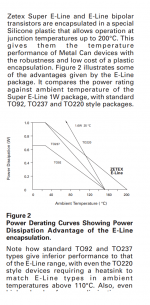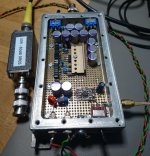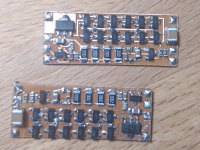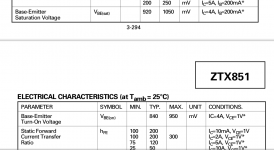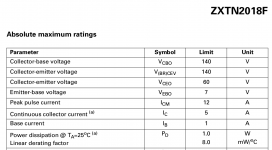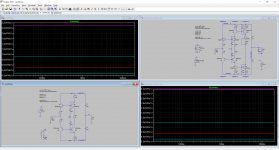You may not realize that Zetex's competitive advantage is that they allow you to run their plastic packaged "E Line" transistors at 200 deg C junction temperature.
I don't know of any epoxy based package with a plastic transition point that high. Not to say someone has not invented one.
I don't know of any epoxy based package with a plastic transition point that high (200C). Not to say someone has not invented one.
Snippet from their website
_
Attachments
those zetex transistors are more like MJ15031,32 stuffed into a TO92 package.
200v 5A continuous 20A peak. this thing should be in a TO-220 package and used for outputs.
Correct. Actually, MJ15031/15032 are pretty good as low noise devices. As are many other power devices.
By exchanging the biasing and load resistors with current sources you get a very high gain however the output impedance goes up as well and bandwidth is going down (it's somewhere near 20 kHz vs. 1 MHz). You may check your approach by replacing the 1M output resistor with a typical RIAA MM amp input of 47k with 200pF in parallel.All,
This version have ~ same input noise density (~170pV/root(Hz) and more gain (~69dB).
By exchanging the biasing and load resistors with current sources you get a very high gain however the output impedance goes up as well and bandwidth is going down (it's somewhere near 20 kHz vs. 1 MHz). You may check your approach by replacing the 1M output resistor with a typical RIAA MM amp input of 47k with 200pF in parallel.
Output impedance is not so high : ~5kohm, and bandwidth around 60kHz is sufficiant.
You can reduce the gain and increase the bandwidth by lowering the output resistor.
Attachments
Can I just confirm where you got Rbb for these devices?
I actually typed that in yesterday and thought, to hell with it and deleted it
170 pV/rt Hz does seem awfully low.

Can I just confirm where you got Rbb for these devices?
I made no change on the model taken on Diodes site.
Rb = 29mohm & 25mohm
with these value input noise density is ~170pV/sqrt(Hz), input referred rms noise 20-20k is 24nV
with Rb = 1 ; density 194pV/sqrt(Hz) rms noise 20-20k is 27nV
with Rb = 10 ; density 347pV/sqrt(Hz) rms noise 49nV
I actually typed that in yesterday and thought, to hell with it and deleted it
170 pV/rt Hz does seem awfully low.

+1 👍
Why start the discussion all over again
ah ok, we proved about 20 pages back those models are no good.
I know.
I just did a comparison with the schematics in #375, with the same models and get ~same noise (different current) and more gain.
I don't think that we have proofed anything.
The 70 pV/rtHz amplifier from ArtOfElectronics V3 works as
advertized; I could verify its 70 pV/rtHz for the single-ended
version with 16 Transistors; the SMD version with only 12
has slightly more.
I see no reason to doubt H&H's number of 1.2 Ohm, derived
from their own noise measurements.
And IB=1Amax for the SMD version, Ptot=1.2W for the ZXTN2019F
Sot-23 version does not leave much space for RB. Don't forget
that there are 700 mW already for the BE diode.
Nor does the Vbe rating @Ib=200 mA for the 951 leave much room for large Rbb.
ed.
That attenuator 50 Ohm/50 mOhm was very helpful for voltage gain measurements.
The 70 pV/rtHz amplifier from ArtOfElectronics V3 works as
advertized; I could verify its 70 pV/rtHz for the single-ended
version with 16 Transistors; the SMD version with only 12
has slightly more.
I see no reason to doubt H&H's number of 1.2 Ohm, derived
from their own noise measurements.
And IB=1Amax for the SMD version, Ptot=1.2W for the ZXTN2019F
Sot-23 version does not leave much space for RB. Don't forget
that there are 700 mW already for the BE diode.
Nor does the Vbe rating @Ib=200 mA for the 951 leave much room for large Rbb.
ed.
That attenuator 50 Ohm/50 mOhm was very helpful for voltage gain measurements.
Attachments
Last edited:
I just simulated the circuit and found some interesting behaviour which is quite different from what we discussed so far!+1 👍
Why start the discussion all over again
When simulating with the adapted ZTX models we used, I get 4.5mA of collector current through all transistors and a RTI noise density of 242 nV/rtHz at Rs = 0R (=noise of amplifier alone, the extreme low noise of 170pV/rtHz can only be achieved wit Rbb =0 and very high currents)
With Rs = 10R, noise density is 734 nV/rtHz which is by far more than the theoretical value of noise of amp + noise of 10R which should be 470nV/rtHz in total.
So it seems that the source resistance changes the noise gain in a different way than the signal gain (signal gain is going down as expected, noise gain seems to stay high).
When setting the current mirror degeneration resistors from 11R to 2k (also setting supply voltage higher to 20V which alone does not change noise, required to avoid voltage clipping as 2 k at 4.5mA result in 9V voltage drop), currents remain the same at 4.5 mA but noise is now 206 nV/rtHz with Rs = 0R and 475 nV/rtHz for Rs = 10R which now is close to the theoretical value of 455nV/rtHz.
When simulating with the adapted ZTX models we used, I get 4.5mA of collector current through all transistors and a RTI noise density of 242 nV/rtHz at Rs = 0R (=noise of amplifier alone, the extreme low noise of 170pV/rtHz can only be achieved wit Rbb =0 and very high currents)
Collector current of transistors depends of jfet current, not ztx model. So it seems that we have not the same jfet model.
As I said before, the noise value is obtained with the manufacturer Rbb and ~9mA current.
When setting the current mirror degeneration resistors from 11R to 2k (also setting supply voltage higher to 20V which alone does not change noise, required to avoid voltage clipping as 2 k at 4.5mA result in 9V voltage drop), currents remain the same at 4.5 mA but noise is now 206 nV/rtHz with Rs = 0R and 475 nV/rtHz for Rs = 10R which now is close to the theoretical value of 455nV/rtHz.
Lowering the noise by increasing the degeneration resistors value is not really a surprise.
But what is interesting is the fact, that the current mirrors introduce a noise component that results in an input current noise density of approx. 58nA/rtHz (= 580nV/rtHz voltage noise at 10R source impedance). If you tame the high gain to usefull levels by reducing the load resistor to 100R ... 500R, the RTI noise level stays the same.
And that is in my view a major drawback compared to all other designs in Bonsai's compendium as none of them has such a significant input current noise component that results in a far larger noise for practical MC pick up source resistances than all voltage noise sources. Only if you use a source impedance < 1R, this current noise components does not hurt anymore. (resulting voltage noise then will be 25-30% of the amps voltage noise)
And that is in my view a major drawback compared to all other designs in Bonsai's compendium as none of them has such a significant input current noise component that results in a far larger noise for practical MC pick up source resistances than all voltage noise sources. Only if you use a source impedance < 1R, this current noise components does not hurt anymore. (resulting voltage noise then will be 25-30% of the amps voltage noise)
But what is interesting is the fact, that the current mirrors introduce a noise component that results in an input current noise density of approx. 58nA/rtHz (= 580nV/rtHz voltage noise at 10R source impedance). If you tame the high gain to usefull levels by reducing the load resistor to 100R ... 500R, the RTI noise level stays the same.
I don't see any reason why the current mirror would cause a so large input current noise.
Simulations performed with a lower current source (4.5mA) and modified Rbb (1.6 ohm) show the same behaviour as #375 schematics with different Rg value.
For Rg = 1 to 100 ohm the output noise is exactly proportional to the output resistor Rl from 10 to 1kohm.
Attachments
I don't see any reason why the current mirror would cause a so large input current noise.
Simulations performed with a lower current source (4.5mA) and modified Rbb (1.6 ohm) show the same behaviour as #375 schematics with different Rg value.
For Rg = 1 to 100 ohm the output noise is exactly proportional to the output resistor Rl from 10 to 1kohm.
Sorry, I don't have this classic paper at hand...
Noise characteristics of current mirror sinks/sources - IEEE Journals & Magazine
The basic plot is that, somehow counterintuitive, the lower the degeneration the higher the current mirror noise is.
The basic plot is that, somehow counterintuitive, the lower the degeneration the higher the current mirror noise is.
Same general principle as a "noiseless" 1000V battery and a 1Meg resistor. You have 1mA in the resistor with 1/31.6 shot noise. In fact IIRC the magic number is 2Vt across the resistor
The basic plot is that, somehow counterintuitive, the lower the degeneration the higher the current mirror noise is.
Yes, it's exactly what I said to aboos.
Lowering the noise by increasing the degeneration resistors value is not really a surprise.
- Home
- Source & Line
- Analogue Source
- Richard Lee's Ultra low Noise MC Head Amp
